Palynological and Morphological Variations in Allergenic Wild Plants
| Received 13 May, 2025 |
Accepted 29 Jun, 2025 |
Published 30 Jun, 2025 |
Background and Objective: Airborne pollen grains became from the most important causative of respiratory allergy within both children and adults. The objective of this study is to investigate the palyno-morphological characteristics of selected allergenic wild plant species with a focus on identifying variations in pollen size, shape, aperture type, exine ornamentation and other diagnostic features. Materials and Methods: Flowers and flower buds of twelve species known as causatives of respiratory allergy worldwide were collected from Alexandria Roads, Egypt. These species are perennials with different life forms, three herbs, seven angiosperm and two gymnosperm trees. The pollen grains were acetolyzed and examined by light microscope, while non acetolyzed pollen grains were sputtered onto Aluminum stubs coated with Gold, examined and photographed using a Scanning Electron Microscope. Results: The data obtained revealed that all the studied taxa have small size pollen grains with variable types and numbers of apertures varied from the pantoporate, colpate to colporate. The exine was thin tectate with different ornamentation. The mass percentage of the measured element contents, generally low, but the nitrogen contents, which can be indicated to the protein content, varied between the taxa. The high nitrogen contents were Tamarix nilotica, Clerodendron inerme, Amaranthus viridis and Chenopodium murale, while the two gymnosperm trees have low nitrogen contents. Conclusion: The results showed that the studied taxa induce allergy in different degrees, causing severity symptoms. The angiosperm trees and herbs are more allergic than the gymnosperm trees. Allergy is not restricted to certain plant, but it depends on the quantity of pollen grains released by plant in the air beside several environmental factors and personal history.
| Copyright © 2025 Taia and Bassiouni. This is an open-access article distributed under the Creative Commons Attribution License, which permits unrestricted use, distribution, and reproduction in any medium, provided the original work is properly cited. |
INTRODUCTION
Allergy has become an important subject for investigation in recent years as a result of climate, environment and vegetation alteration1-3. Airborne pollen allergy, commonly known as pollinosis, has become a serious allergic disease, especially in villages and greenery areas4. Allergic disease has altered from being a rare personal condition to be pandemic health problem. This problem has increased due to both climate change and greenhouse gas air pollution. These two variables greatly affect both the quantity and elemental compositions of the pollen grains. At the same time, the sensitization rate to the pollens has increased in both children and adults, especially in the polluted areas5. Moreover, allergenic plants, such as Tamarix nilotica, Pinus pinea, Amaranthus viridis and Chenopodium murale produce a huge amount of pollen grains which cause severe allergic symptoms. These plants have naked or exposed flowers producing small-sized pollen grains, which makes it easy to be carried by winds6. Air polluted by pollen grains and fungal spores is considered of the major causes of respiratory allergy all over the world7-9. While skin and food allergy can be due to entomophilous plants which are pollinated by insects and their pollens are ornamented by spines, causing itching or swelling over the foods, causing Oral allergy Syndrome (OAS).
In asthmatic people, when they inhale pollen grains, their immune system mistakenly identifies the pollen grains as a dangerous invader. Then the immune system produces defensive chemicals such as histamine, besides other chemicals and starts allergic reactions. This reaction causes numerous irritating symptoms depending on the genetic history of the people and both the amount and type of pollen grains10-12. Taia and Zayed13 classified the allergic responses into two categories: Those resulting from inhaling natural biological materials such as pollen grains, mould, bacteria, hyphae and so on and those resulting from chemical contaminations and air pollution. Most of the works concentrated on the pollen grains that cause pollinosis and respiratory problems. Popesco14 found that most of the peoples suffering from pollinosis has pollen-related food allergy at the same time. He mentioned that the proteins present in some vegetables, fruits and nuts react with the pollen grains, causing oral allergy syndrome (OAS). The pollen grains themselves contain different types of proteins, fats, adenosine and minerals inside their protoplast, which are released during the rehydration process and react with the mucous membrane, causing allergic symptoms8,15,16. They found that allergy is not restricted to certain trees, shrubs or herbs, but it depends on the quantity of pollen grains released by the plant into the air with several environmental factors and personal history. Taia and Zayed15 clarified the effect of some widely cultivated road tree pollen grains on stimulating allergic reactions. Taia and Bassiouni9 recorded the pollen incidence in Alexandria City, Egypt, during the full year. The recorded types of pollen grains were mainly of Chenopodiaceae/Amaranthaceae complex, followed by Casuarina, Arecaceae, Pinus then Utrica. This record indicated that not only are trees and shrubs the main causes of pollinosis, but also herb pollen grains have allergenic stimulation.
This work has been done to investigate the pollen morphological variations and pollen mineral compositions within twelve wild road plants to evaluate the more allergenic pollen morphological features within the studied taxa.
MATERIALS AND METHODS
Study area: Alexandria City is the second largest city in Egypt, after Cairo. It lies on the shore of the Mediterranean Sea, in North Africa. The city is characterized by its humid climate all year.
Materials: Flowers and flower buds of twelve species were collected from Alexandria streets during the period from September to December, 2024; these species are perennials with different life forms, three herbs, seven angiosperm roadside trees and two gymnosperm trees (Table 1). This collection is from the known allergic taxa9.
Pollen preparation for light microscopy: The anthers were carefully removed from the flowers immediately after collection using a stereomicroscope. The pollen grains were then acetolyzed17, mounted on glass slides and examined under a light microscope for measurements. Measurements were recorded based on the mean values of twenty pollen grains per taxon.
Scanning Electron Microscopy (SEM) examination: For SEM analysis, non-acetolyzed pollen grains were sputter-coated with gold after mounting onto aluminum stubs. These samples were examined and photographed using a JEOL JSM-IT 200 SEM housed at the Faculty of Science, Alexandria University. The accelerating voltage (kV) was adjusted according to the exine thickness and surface ornamentation.
| Table 1: | Studied species and their life forms and taxonomic ranking | |||
| No. | Taxa | Family | Division | Life form |
| 1 | Amaranthus viridis L. | Amaranthaceae | Angiosperms | Herb |
| 2 | Chenopodium murale L. | Chenopodiaceae | ||
| 3 | Suaeda vermiculata Forssk | Chenopodiaceae | ||
| 4 | Cassia senna L. | Caesalpinaceae | Tree | |
| 5 | Catharanthus roseus (L.) G. Donn | Apocynaceae | ||
| 6 | Cerastium nocturnum L. | Bignoniaceae | ||
| 7 | Clerodendrom inerme L. | Verbenaceae | ||
| 8 | Datura inoxia Mill | Solanaceae | ||
| 9 | Punica granatum L. | Lythraceae | ||
| 10 | Tamarix nilotica (Ehrenb.) Bge | Tamaricaceae | ||
| 11 | Ginkgo biloba L. | Ginkgoaceae | Gymnosperms | |
| 12 | Pinus pinea L. | Pinaceae |
X-ray analysis for mineral content: Pollen grain pellets prepared from the studied species were subjected to X-ray analysis at less than 20 kV using the same JEOL JSM-IT 200 SEM model. This analysis was conducted to determine the elemental mineral content. The terminology used throughout the palynological descriptions follows the standard reference (Table 1)18.
RESULTS
Pollen morphological features: The pollen morphological variations are summarized in Table 2, while the element contents of the studied taxa are summarized in Table 3. From Table 2, only the three herbs, Amaranthus viridis, Chenopodium murale and Suaeda vermiculata, have apolar spheroidal, pantoporate pollen grains (Fig. 1-3). Despite Datura inoxia having spheroidal pollen grains but it has tricolpate apertures, which makes it isopolar (Fig. 4-8). All the studied taxa have radiosymmetric pollen grains (Fig. 9-11) except those of Pinus pinea, which have bilateral symmetric pollen grains due to the presence of two big sacci surrounding the corpus (Fig. 12).
In Table 2, the pollen morphological characteristics of the studied taxa exhibit distinct variations in polarity, shape, aperture type and exine ornamentation. Amaranthus viridis and Chenopodium murale produce apolar, spheroidal, porate pollen grains with a P/E ratio of 1.0 and tectate-granulate exine. Similarly, Suaeda vermiculata also has apolar, spheroidal, porate grains, though with reticulate ornamentation. In contrast, Cassia senna, Catharanthus roseus, Cerastium nocturnum, Clerodendrum inerme, Datura inoxia, Punica granatum and Tamarix nilotica produce isopolar pollen with colpate or colporate apertures. Among them, Cassia senna and Catharanthus roseus exhibit prolate to subprolate shapes with punctate exine, while Cerastium nocturnum and Clerodendrum inerme show tectate-striate and tectate patterns, respectively. Datura inoxia and Punica granatum have spheroidal and prolate colpate pollen with punctate and scabrate exine, respectively. Tamarix nilotica shows subprolate colpate pollen with a reticulate surface. Ginkgo biloba and Pinus pinea L., both gymnosperms, produce isopolar sulcate pollen; Ginkgo has prolate, rugulate grains, while Pinus exhibits oblate, scabrate grains. This diversity highlights taxon-specific palynological features useful for systematic and taxonomic interpretations.
In Table 3, the elemental composition of the studied taxa reveals variability across macro- and microelements. Amaranthus viridis and Chenopodium murale show moderate levels of zinc (0.13-0.29%), copper (0.28-0.29%), calcium (0.33-0.38%) and potassium (0.70-0.80%), with oxygen constituting over 33% of their mass, while carbon ranges between 53-58%. Suaeda vermiculata contains lower concentrations of most elements, notably higher chlorine (2.13%) but reduced carbon content (~50%). Cassia senna, Catharanthus roseus and Cerastium nocturnum maintain consistent zinc and copper levels (0.24-0.26 and 0.26-0.48%, respectively) and display substantial oxygen and carbon content (~24-35 and ~57-61%, respectively). Clerodendrum inerme and Datura inoxia show similar elemental profiles with slightly higher iron and silicon values. Punica granatum stands out with elevated calcium (0.80%) and oxygen (36.62%) but comparatively lower carbon (58.84%).
| Table 2: | Main pollen grain morphological characters of the studied species | |||
| Aperture | Exine | |||||||||||
| No. | Taxa | Polarity | Mean PAL | Mean EAD | P/E | Shape | Type | No. | IP/IC | D/L | Th. | Or. |
| 1 | Amaranthus viridis | Apolar | 17.4±1.25 | 17.4±1.25 | 1 | Sph | Porate | 28 | 2.8±0.22 | 1.5±0.21 | 1.6±0.12 | TG |
| 2 | Chenopodium murale | Apolar | 23.5±2.32 | 23.5±2.32 | 1 | Sph | Porate | 36 | 2.2±0.19 | 1.2±0.29 | 1.8±0.2 | TG |
| 3 | Suaeda vermiculata | Apolar | 38.2±3.58 | 38.2±3.58 | 1 | Sph | Porate | 12 | 5.4±0.19 | 0.8±0.82 | 1.6±0.41 | Ret |
| 4 | Cassia senna | Isopolar | 42.2±3.98 | 38±4.02 | 1.09 | Spr | Colporate | 3 | 21.2±3.22 | 38.2±2.33 | 2.5±0.05 | Pun |
| 5 | Catharanthus roseus | Isopolar | 48.2±4.88 | 34.8±3.75 | 1.4 | Pr | Colporate | 4 | 14.6±2.11 | 20.2±1.95 | 2.8±0.2 | Pun |
| 6 | Cerastium nocturnum | Isopolar | 38.2±5.05 | 28.5±4.05 | 1.3 | Pr | Colpate | 3 | 11.5±1.98 | 33.3±3.52 | 2.8±0.2 | Tst |
| 7 | Clerodendrum inerme | Isopolar | 27.6±3.22 | 26.3±3.02 | 1.1 | Spr | Colpate | 3 | 15.2±2.35 | 21.5±2.77 | 2.2±0.22 | Tec |
| 8 | Datura inoxia | Isopolar | 23.5±2.98 | 23.3±4.05 | 1 | Sph | Colpate | 3 | 18.5±2.88 | 21.2±3.12 | 2.2±0.2 | Pun |
| 9 | Punica granatum | Isopolar | 41.5±5.55 | 28.8±3.85 | 1.4 | Pr | Colpate | 3 | 17.8±2.98 | 22.6±3.22 | 2.8±0.19 | Sca |
| 10 | Tamarix nilotica | Isopolar | 43.2±5.03 | 38.4±4.25 | 1.1 | Spr | Colpate | 6 | 8.8±2.03 | 30.2±4.28 | 2.2±0.22 | Ret |
| 11 | Ginkgo biloba | Isopolar | 25.6±3.55 | 22.7±3.19 | 1.1 | Pr | Sulcate | 1 | 0 | 23.8±4.55 | 0.7±0.13 | Rug |
| 12 | Pinus pinea L. | Isopolar | 32.6±4.05 | 38.8±5.02 | 0.8 | Ob | Sulcate | 1 | 0 | 16.4±1.08 | 1.0±0.11 | Sca |
| EAD: Equatorial axis diameter, PAL: Polar axis length, Pun: Punctate, Ret: Reticulate, Rug: Rugate, Sca: Scabrate, Sph: Spheroidal, Spr: Subprolate, TH: Thickness, Or.: Ornamentation, Tec: Tectate echinate, TG: Tectate granulate and Tst: Tectate striate | ||||||||||||
| Table 3: | Summary of the investigated minerals within the studied taxa as shown by X-ray analyses | |||
| Mass of investigated elements (%) | |||||||||||||||
| Taxa | C | N | O | Na | Mg | Al | Si | P | S | Cl | K | Ca | Fe | Cu | Zn |
| A. viridis | 53.84±0.19 | 10.21±0.21 | 33.62±0.39 | 0.06±0.02 | 0.14±0.02 | 0.05±0.01 | 0.05±0.0 | 0.28±0.02 | 0.17±0.01 | 0.0 | 0.80±0.03 | 0.33±0.02 | 0.04±0.02 | 0.28±0.04 | 0.13±0.04 |
| C. murale | 57.85±0.23 | 6.28±0.22 | 33.24±0.45 | 0.11±0.03 | 0.0 | 0.08±0.02 | 0.0 | 0.21±0.03 | 0.12±0.02 | 0.05±0.01 | 0.70±0.0 | 0.38±0.03 | 0.03±0.03 | 0.29±0.06 | 0.29±0.06 |
| S. vermiculate | 50.11±0.2 | 2.11±0.22 | 31.06±0.39 | 14.22±0.02 | 0.05±0.02 | 0.02±0.02 | 0.12±0.02 | 0.03±0.02 | 0.01±0.01 | 2.13±0.01 | 0.33±0.03 | 0.18±0.02 | 0.04±0.02 | 0.06±0.05 | 0.02±0.05 |
| C. senna | 57.59±0.28 | 11.97±0.51 | 24.77±0.49 | 0.07±0.03 | 0.03±0.02 | 0.11±0.02 | 0.42±0.03 | 0.03±0.02 | 0.0 | 1.99±0.06 | 0.02±0.02 | 0.22±0.03 | 0.06±0.02 | 0.48±0.07 | 0.24±0.07 |
| C. roseus | 60.16±0.2 | 2.11±0.22 | 35.26±0.39 | 0.08±0.02 | 0.05±0.02 | 0.20±0.02 | 0.19±0.02 | 0.22±0.02 | 14±0.01 | 0.13±0.01 | 65±0.03 | 0.28±0.02 | 0.04±0.02 | 0.26±0.05 | 0.25±0.05 |
| C. nocturnum | 60.86±0.24 | 2.75±0.28 | 33.03±0.46 | 0.03±0.03 | 0.37±0.03 | 0.02±0.02 | 0.06±0.02 | 0.66±0.03 | 0.25±0.02 | 0.36±0.03 | 0.65±0.04 | 0.41±0.03 | 0.03±0.02 | 0.27±0.05 | 26±0.06 |
| C. inerme | 57.54±0.22 | 12.00±0.51 | 24.77±0.49 | 0.07±0.03 | 0.08±0.02 | 0.35±0.02 | 0.62±0.03 | 0.13±0.02 | 0.85±0.04 | 2.29±0.06 | 0.05±0.02 | 0.38±0.03 | 0.15±0.02 | 0.48±0.07 | 0.24±0.07 |
| D. inoxia | 56.61±0.22 | 10.24±0.71 | 28.71±0.49 | 0.28±0.03 | 0.03±0.02 | 0.11±0.02 | 0.42±0.03 | 0.03±0.02 | 0.52 | 1.99±0.06 | 0.05±0.02 | 0.27±0.03 | 0.06±0.02 | 0.48±0.07 | 0.24±0.07 |
| P. granatum | 58.84±0.19 | 2.22 ±0.21 | 36.62±0.49 | 0.06±0.03 | 0.14±0.02 | 0.05±0.01 | 0.05±0.03 | 0.23±0.02 | 0.22±0.01 | 0.0 | 0.80±0.02 | 0.33±0.03 | 0.04±0.02 | 0.13±0.05 | 0.11±0.04 |
| T. nilotica | 57.42±0.22 | 12.03±0.51 | 25.77±0.49 | 0.31±0.03 | 0.14±0.02 | 0.08±0.02 | 0.44±0.03 | 0.23±0.02 | 0.18±0.01 | 1.95±0.06 | 0.52±0.02 | 0.22±0.03 | 0.06±0.02 | 0.42±0.07 | 0.14±0.07 |
| G. biloba | 60.59±0.22 | 0.77 ±0.02 | 34.01±0.42 | 0.02 | 0.29±0.03 | 0.0 | 0.0 | 1.20 ± 0.04 | 0.30±0.02 | 0.0 | 2.40±0.06 | 0.42 ± 0.03 | 0.0 | 0.0 | 0.0 |
| P. pinae | 59.25±0.2 | 3.28 ±0.31 | 32.27±0.6 | 0.51±0.6 | 0.29±0.02 | 0.0 | 0.0 | 0.77±0.03 | 0.20±0.02 | 0.95±0.03 | 0.93±0.04 | 0.0 | 0.0 | 0.0 | 0.0 |
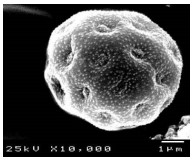
|
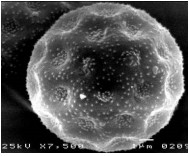
|

|
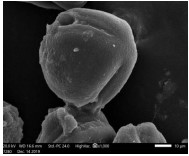
|
Gymnosperms Ginkgo biloba and Pinus pinea differ with negligible zinc and copper but higher calcium (0.42 and 0.93%) and potassium (~2.4 and 0.95%), with carbon around 59-60%. This elemental variation reflects species-specific biochemical adaptations and may influence physiological and ecological functions.
According to the pollen size, three categories were found. The very small pollen grains, which were less than 20 μm, were recorded in Amaranthus viridis only. The second category has taxa with small pollen grains, from 20-30 μm, recorded in six taxa: Chenopodium murale, Cerastium nocturnum, Clerodendrom inerme, Datura inoxia, Punica granatum and Ginkgo biloba. The third category has taxa with medium-sized pollen grains, more than 30 μm, recorded in five taxa, Suaeda vermiculata, Cassia senna, Catharanthus roseus, Tamarix nilotica and Pinus pinea. The pollen grain shapes differed from spheroidal to subprolate and prolate, except in Pinus pinea, where the corpus was oblate with two large wings.
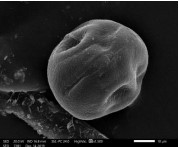
|

|

|

|
Aperture types varied from the pantoporate in the three herb taxa to the Colporate in both Cassia senna and Catharanthus roseus (Fig. 4-5) with wide, long and narrow pores. Apertures were colpate in the rest of the studied angiosperm trees (Fig. 6-10) with long colpi in Cassia senna, Cerastium nocturnum, Clerodendrom inerme.

|
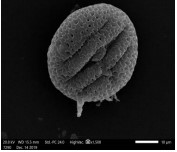
|

|

|
The colpate apertures were mostly three, except in Catharanthus roseus, which was four (Fig. 5) and in Tamarix nilotica, which was six (Fig. 10). In the two gymnosperm trees, the aperture was monosulcate (Fig. 11-12).
The exine was mostly thin in all the taxa with different exine sculpture. The exine was tectate granulate in Amaranthus viridis and Chenopodium murale (Fig. 1-2), reticulate in Suaeda vermiculata and Tamarix nilotica (Fig. 3 and 10), tectate striate in Cerastium nocturnum and rugate in Ginkgo biloba (Fig. 6 and 11), tectate punctuate in Cassia senna, Catharanthus roseus, Datura inoxia (Fig. 4, 5 and 8). Tectate echinate exine was recorded in Clerodendrum inerme only, while scabrate exine ornamentation was found in both Punica granatum and Pinus pinea (Fig. 9 and 12).
DISCUSSION
Works on pollen allergy, concentrated on those causing respiratory problems to both children and adults. Identification of the main trees producing plenty of light, small pollen grains; ranging from 20 to 50 μm, was the main goal in allergy researches18. Pollens of the Poaceae, Chenopodiaceae and Leguminosae stand in the first lines in this respect19. Accordingly, the most well-known types causing pollinosis were those of the Poaceae family, such as Birch, Oak, Grass and Ragweed pollen20-23. Popescu14 mentioned that the pollen grains not only cause respiratory problems, but they also react with the proteins in fresh fruit, vegetables and nuts, causing oral allergy syndrome (OAS)24.
Songnuan25 mentioned that the analyses of pollen chemistry have shown that the dry mass of protein pollen ranges from 2.5 to 61%. These wide variations in the protein content can indicate the different types of pollen grains causing severe allergic symptoms. The result obtained from this investigation showed great variations in the nitrogen contents between the studied taxa, which is an indication of the variation in the protein contents.
Songnuan25 found that the wind-pollinated plants have nitrogen pollen grain contents richer than the insect-pollinated plants, which cause severe allergic symptoms. The nitrogen content can be indicated by the amount of protein in the pollen protoplast. In fact12 summarized the types of allergy under eight categories: Drug Allergy, Food Allergy, Insect Allergy, Latex Allergy, Mold Allergy, Pet Allergy, Pollen Allergy and Ragweed Pollen allergy. Mansouritorghabeh et al.19 reported that 40% of allergic people in the Middle East area have been affected by allergic pollen grains besides the global climate change. OH2 pointed to the increases in the air CO2 concentration and atmospheric temperature, raising the amount of air pollens, causing pollinosis. Pollinosis is an allergic reaction induced by glycoprotein derivatives which are in the external part of the pollen grain wall known as Exine. These glycoprotein derivatives bond to specific receptors in the mucous membranes, resulting in the secretion of histamine and causing allergic symptoms15.
D’Amato et al.8 warned of the effects of inhaling a great amount of pollen grains carried by air belonging to different trees, shrubs and herbs. This meant that allergic syndrome can be stimulated by many reasons, not only the type and quantity of pollen grains, but also the protein reactions happen between the pollen grains and the mucous membrane. Accordingly, this investigation has been carried out to clarify both the pollen morphological variations and element contents in the pollen grain of twelve taxa to know the pollen external features and the element contents of the studied taxa to recognize the most allergenic pollen characters.
The results obtained revealed that Amaranthus viridis is the smallest, lightest pollen grains which can be carried easily by winds, followed by Chenopodium murale, Datura inoxia and Ginkgo biloba. The former two types have reasonable quantities of nitrogen (6.28 and 10.21%) while Ginkgo biloba was very poor in nitrogen. Accordingly, the most allergic pollen grains might be small in size, light, with smooth exine and high nitrogen contents. These features were found in Datura inoxia, which is a perennial tree found widely in most of the streets and disturbed areas, followed by Clerodendron inerme, Amaranthus viridis and Chenopodium murale. Tamarix nilotica has high nitrogen contents and is pollinated by winds, but it has large-sized pollen grains, which affect its pollen grains in distribution and elevation. This finding can be in partial agreement with Buchmann24 in considering that the protein content in the pollen protoplast is a more important cause for pollinosis. The two gymnosperm trees, Ginkgo biloba and Pinus pinea, have limited allergic effects as they have small amounts of nitrogen. Taia et al.5 mentioned that small pollen grains with tectate echinate exine have irritating feelings and induce allergic symptoms. This finding supports the recognition of Clerodendron inerme as an allergic pollen grain.
Aperture type and number didn’t prove to have a role in allergy. They affect the degree of hydration of the pollen grains and the amount of their lipid and glycoprotein secretions, stimulating allergy. All the angiosperm studied taxa have pantoporate, tri- or hexa-colpate or tri- or tetra-colporate apertures. The two gymnosperm taxa have monosulccate apertures. This means that all the pollens have different chances to release their chemical stimulants. Božič and Šiber26 made a model to illustrate the bursting of the porate pollen grains to release their chemical contents. They pointed to the effect of air humidity and environmental factors in desiccating the pollen grains and making folds on the surface or sometimes swelling the pollen and bursting it to release their contents. In any case, the result is chemical reactions causing pollinosis and human disorders. Accordingly, the twelve pollen taxa have an allergic effect in different degrees depending on their nitrogen content and their sizes, which affect their distribution. Also, we must consider the degree of humidity and other environmental and climatic conditions, which all cause severe allergic symptoms.
SIGNIFICANCE STATEMENT
Airborne pollen grains have become the most important cause of respiratory allergy in both children and adults. The study investigates the palyno-morphological characteristics of selected allergenic wild plant species with a focus on identifying variations in pollen size, shape, aperture type, exine ornamentation and other diagnostic features. The results showed that the studied taxa induce allergy in different degrees, causing severe symptoms. The angiosperm trees and herbs are more allergenic than the gymnosperm trees. Allergy is not restricted to certain plants, but it depends on the quantity of pollen grains released by the plant in the air, besides several environmental factors and personal history.
CONCLUSION
This study clarified the different morphological features of the twelve studied species with their mineral compositions. All the studied taxa have small pollen grains that can be easily carried by winds, causing respiratory problems. Meanwhile, the studied taxa have low mineral concentrations, but the highest nitrogen contents were Tamarix nilotica, Clerodendron inerme, Amaranthus viridis and Chenopodium murale. The two angiosperm trees, Ginkgo biloba and Pinus pinea, have low nitrogen contents and accordingly their allergic effect is limited. The results showed that the twelve studied taxa can induce allergy in one way or another, with different symptoms. All pollen grains have allergic effects in one way or another and peoples who has an allergic history must avoid being in the pollen-polluted areas. The angiosperm trees and herbs are more allergenic than the gymnosperm trees.
REFERENCES
- Seedat, R.Y., 2019. Environmental control of outdoor allergens. Curr. Allergy Clin. Immunol., 32: 12-14.
- Oh, J.W., 2022. Pollen allergy in a changing planetary environment. Allergy Asthma Immunol. Res., 14: 168-181.
- Oh, J.W., 2023. Pollen Allergy in a Changing World: A Guide to Scientific Understanding and Clinical Practice. 2nd Edn., Springer, Singapore, ISBN: 978-981-99-4647-1, Pages: 172.
- Stewart, G.A. and C. Robinson, 2017. Indoor and Outdoor Allergens and Pollutants. In: Middleton's Allergy Essentials, O'Hehir, R.E., S.T. Holgate and A. Sheikh (Eds.), Elsevier, Amsterdam, Netherlands, ISBN: 9780702050329, pp: 73-116.
- Taia, W.K., W.M. Amer, A.B. Hamed and A.M. Abd El-Maged, 2025. Phenopalynological study of some ornamental species in the Giza Region, Egypt. Nat. Environ. Pollut. Technol., 24.
- D'amato, G. and F.T.M. Spieksma, 1991. Allergenic pollen in Europe. Grana, 30: 67-70.
- McInnes, R.N., D. Hemming, P. Burgess, D. Lyndsay and N.J. Osborne et al., 2017. Mapping allergenic pollen vegetation in UK to study environmental exposure and human health. Sci. Total Environ., 599-600: 483-499.
- D’Amato, G., L. Cecchi, S. Bonini, C. Nunes and I. Annesi-Maesano et al., 2007. Allergenic pollen and pollen allergy in Europe. Allergy, 62: 976-990.
- Taia, W.K. and E.M. Bassiouni. 2022. Airborne allergenic pollen grains in Alexandria City, Egypt. Acta Sci. Microbiol., 5: 102-109.
- Choi, S.W., J.H. Lee, Y. Kim, I.B. Oh and K.R. Choi, 2014. Association between the sensitization rate for inhalant allergens in patients with respiratory allergies and the pollen concentration in Ulsan, Korea. Korean J. Med., 86: 453-461.
- Hosoki, K., I. Boldogh and S. Sur, 2015. Innate responses to pollen allergens. Curr. Opin. Allergy Clin. Immunol., 15: 79-88.
- Buters, J.T.M., C. Antunes, A. Galveias, K.C. Bergmann and M. Thibaudon et al., 2018. Pollen and spore monitoring in the world. Clin. Transl. Allergy, 8.
- Taia, W.K. and A.A. Zayed, 2022. Common road tree pollen grain contents and their cause on allergy. Int. J. Med. Sci. Acad. Res., 3: 1-13.
- Popescu, F.D., 2015. Cross-reactivity between aeroallergens and food allergens. World J. Methodol., 5: 31-50.
- Taia, W.K. and A.A.H. Zayed, 2021. Road tree pollen grain contents and effect on the immune system. Quantum J. Med. Health Sci., 1: 34-50.
- Taia, W.K., A.A. Zayed, A.M. Asker and S.A.H. Mohamed, 2022. Road tree pollen grains sensation to allergy and their effects on the immune system. Acta Sci. Microbiol., 5: 74-81.
- Erdtman, G., 1969. Handbook of Palynology: Morphology, Taxonomy, Ecology: An Introduction to the Study of Pollen Grains and Spores. Hafner Publication Co., New York, USA, Pages: 468.
- Punt, W., P.P. Hoen, S. Blackmore, S. Nilsson and A. le Thomas, 2007. Glossary of pollen and spore terminology. Rev. Palaeobot. Palynol., 143: 1-81.
- Mansouritorghabeh, H., F. Jabbari-Azad, M. Sankian, A. Varasteh and R. Farid-Hosseini, 2019. The most common allergenic tree pollen grains in the Middle East: A narrative review. Iran. J. Med. Sci., 44: 87-98.
- Demirpolat, A. and P.Y. Sancar, 2023. Pollen visualization of Turkish flora of selected plant species under light, scanning, and transmission microscopy. Agronomy, 13.
- Damialis, A. and G.N. Konstantinou, 2011. Cereal pollen sensitisation in pollen allergic patients: To treat or not to treat? Eur. Ann. Allergy Clin. Immunol., 42: 36-44.
- García-Mozo, H. 2017. Poaceae pollen as the leading aeroallergen worldwide: A review. Allergy, 72: 1849-1858.
- Bartra, J., J. Sastre, A. del Cuvillo, J. Montoro, I. Jáuregui et al., 2009. From pollinosis to digestive allergy. J. Invest. Allergology Clin. Immunol., 19: 3-10.
- Buchmann, S.L., 1986. Vibratile Pollination in Solanum and Lycopersicon: A Look at Pollen Chemistry. In: Solanaceae, Biology and Systematics, D'Arcy, W.G., Columbia University Press, New York, ISBN: 9780231057806, pp: 238-252.
- Songnuan, W., 2013. Wind-pollination and the roles of pollen allergenic proteins. Asian Pac. J. Allergy Immunol., 31: 261-270.
- Božič, A. and A. Šiber, 2022. Mechanics of inactive swelling and bursting of porate pollen grains. Biophys. J., 121: 782-792.
How to Cite this paper?
APA-7 Style
Taia,
W.K., Bassiouni,
E.M. (2025). Palynological and Morphological Variations in Allergenic Wild Plants. Research Journal of Botany, 20(1), 160-169. https://doi.org/10.3923/rjb.2025.160.169
ACS Style
Taia,
W.K.; Bassiouni,
E.M. Palynological and Morphological Variations in Allergenic Wild Plants. Res. J. Bot 2025, 20, 160-169. https://doi.org/10.3923/rjb.2025.160.169
AMA Style
Taia
WK, Bassiouni
EM. Palynological and Morphological Variations in Allergenic Wild Plants. Research Journal of Botany. 2025; 20(1): 160-169. https://doi.org/10.3923/rjb.2025.160.169
Chicago/Turabian Style
Taia, Wafaa, Kamal, and Eman M. Bassiouni.
2025. "Palynological and Morphological Variations in Allergenic Wild Plants" Research Journal of Botany 20, no. 1: 160-169. https://doi.org/10.3923/rjb.2025.160.169

This work is licensed under a Creative Commons Attribution 4.0 International License.


